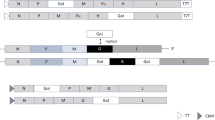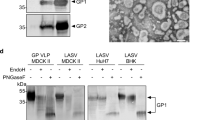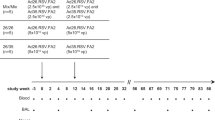Abstract
Vectors based on Semliki Forest virus (SFV) have been widely used in vitro and in vivo to express heterologous genes in animal cells. In particular, the ability of recombinant SFV (rSFV) to elicit specific, protective immune responses in animal models suggests that rSFV may be used as a vaccine vehicle. In this study, we examined the distribution of rSFV in vivo by immunohistochemistry and RT-PCR after intravenous, intramuscular and subcutaneous injection of rSFV particles and related this to the degree of cytotoxic T lymphocyte (CTL) responses and frequency of specific T cells detected by MHC-I tetramers. We found that after i.v. injection, rSFV-RNA was distributed to a variety of different tissues, whereas it was confined locally after i.m. and s.c. injections. The persistence of the rSFV vector was transient, and no viral RNA could be detected 10 days after inoculation. All tested routes of immunization generated significant levels of antigen-specific CTL responses and increased numbers of specific CD8+T cells, as detected by tetramer binding. The distribution of antigen-specific CTLs correlated with the in vivo distribution pattern of rSFV, with a highest frequency in the spleen or local lymph node, depending on the injection route.
This is a preview of subscription content, access via your institution
Access options
Subscribe to this journal
Receive 12 print issues and online access
$259.00 per year
only $21.58 per issue
Buy this article
- Purchase on Springer Link
- Instant access to full article PDF
Prices may be subject to local taxes which are calculated during checkout





Similar content being viewed by others
References
Strauss JH, Strauss EG . The alphaviruses: gene expression, replication and evolution Microbiol Rev 1994 58: 491–562
Smerdou C, Liljestrom P . Alphavirus vectors: from protein production to gene therapy Gene Ther Reg 1999 1: 1–31
Liljeström P, Garoff H . A new generation of animal cell expression vectors based on the Semliki Forest virus replicon Bio/Technology 1991 9: 1356–1361
Smerdou C, Liljestrom P . Two-helper RNA system for production of recombinant Semliki forest virus particles J Virol 1999 73: 1092–1098
Zhou X et al. Generation of cytotoxic and humoral immune responses by nonreplicative recombinant Semliki Forest virus Proc Nat Acad Sci USA 1995 92: 3009–3013
Schirmacher V et al. Intra-pinna anti-tumor vaccination with self-replicating infectious RNA or with DNA encoding a model tumor antigen and a cytokine Gene Therapy 2000 7: 1137–1147
Berglund P, Fleeton MN, Smerdou C, Liljestrom P . Immunization with recombinant Semliki Forest virus induces protection against influenza challenge in mice Vaccine 1999 17: 497–507
Fleeton MN, Liljestrom P, Sheahan BJ, Atkins GJ . Recombinant Semliki Forest virus particles expressing louping ill virus antigens induce a better protective response than plasmid-based DNA vaccines or an inactivated whole particle vaccine J Gen Virol 2000 81: 749–758
Chen M et al. Intranasal vaccination with recombinant Semliki Forest virus protects against respiratory syncytial virus infection (submitted)
Mossman SP et al. Protection against lethal simian immunodeficiency virus SIVsmmPBj14 disease by a recombinant Semliki Forest virus gp160 vaccine and by a gp120 subunit vaccine J Virol 1996 70: 1953–1960
Rosenwirth B et al. An anti-HIV strategy combining chemotherapy and therapeutic vaccination J Med Primatol 1999 28: 195–205
Colmenero P, Liljeström P, Jondal M . Induction of P815 tumor immunity by recombinant Semliki Forest virus expressing the P1A gene Gene Therapy 1999 6: 1738–1733
Murphy AM, Morris-Downes MM, Sheahan BJ, Atkins GJ . Inhibition of human lung carcinoma cell growth by apoptosis induction using Semliki Forest virus recombinant particles Gene Therapy 2000 7: 1477–1482
Lundstrom K . Alphaviruses as tools in neurobiology and gene therapy J Recept Signal Transduct Res 1999 19: 673–686
Wahlfors JJ et al. Evaluation of recombinant alphaviruses as vectors in gene therapy Gene Therapy 2000 7: 472–480
Roks AJ et al. Vectors based on Semliki Forest virus for rapid and efficient gene transfer into non-endothelial cardiovascular cells: comparison to adenovirus Cardiovasc Res 1997 35: 498–504
Morris-Downes MM et al. Semliki forest virus-based vaccines: persistence, distribution and pathological analysis in two animal systems Vaccine 2001 19: 1978–1988
Wolff JA et al. Direct gene transfer into mouse muscle in vivo Science 1990 247: 1465–1468
Parker SE et al. Plasmid DNA malaria vaccine: tissue distribution and safety studies in mice and rabbits Hum Gene Ther 1999 10: 741–758
Atkins GJ, Sheahan BJ, Liljestrom P . The molecular pathogenesis of Semliki Forest virus: a model virus made useful? J Gen Virol 1999 80: 2287–2297
Pathak S, Webb HE . Possible mechanisms for the transport of Semliki forest virus into and within mouse brain. An electron-microscopic study J Neurol Sci 1974 23: 175–184
Charles PC, Walters E, Margolis F, Johnston RE . Mechanism of neuroinvasion of Venezuelan equine encephalitis virus in the mouse Virology 1995 208: 662–671
Zhang JR, Tuomanen E . Molecular and cellular mechanisms for microbial entry into the CNS J Neurovirol 1999 5: 591–603
Soilu-Hanninen M et al. Semliki Forest virus infects mouse brain endothelial cells and causes blood–brain barrier damage J Virol 1994 68: 6291–6298
Johnston LJ, Halliday GM, King NJ . Langerhans cells migrate to local lymph nodes following cutaneous infection with an arbovirus J Invest Dermatol 2000 114: 560–568
MacDonald GH, Johnston RE . Role of dendritic cell targeting in Venezuelan equine encephalitis virus pathogenesis J Virol 2000 74: 914–922
Berglund P et al. Enhancing immune responses using suicidal DNA vaccines Nat Biotechnol 1998 16: 562–565
Altman-Hamamdzic S et al. Expression of beta-galactosidase in mouse brain: utilization of a novel nonreplicative Sindbis virus vector as a neuronal gene delivery system Gene Therapy 1997 4: 815–822
Glasgow GM, McGee MM, Sheahan BJ, Atkins GJ . Death mechanisms in cultured cells infected by Semliki Forest virus J Gen Virol 1997 78: 1559–1563
Griffin DE, Hardwick JM . Regulators of apoptosis on the road to persistent alphavirus infection Annu Rev Microbiol 1997 51: 565–592
Levine B et al. Conversion of lytic to persistent alphavirus infection by the bcl-2 cellular oncogene Nature 1993 361: 739–742
Albert ML, Sauter B, Bhardwaj N . Dendritic cells acquire antigen from apoptotic cells and induce class I-restricted CTLs Nature 1998 392: 86–89
Holmgren L et al. Horizontal transfer of DNA by the uptake of apoptotic bodies Blood 1999 93: 3956–3963
Berglund P et al. Semliki Forest virus expression system: production of conditionally infectious recombinant particles Bio/Technology 1993 11: 916–920
Liljeström P, Garoff H . Expression of proteins using Semliki Forest virus vectors In: Ausubel FM et al (eds) Current Protocols in Molecular Biology Greene Publishing Associates and Wiley Interscience: New York 1994 pp 16.20.11–16.20.16
Fleeton MN et al. Recombinant Semliki Forest virus particles encoding the prME or NS1 proteins of louping ill virus protect mice from lethal challenge J Gen Virol 1999 80: 1189–1198
Kambayashi T et al. Emergence of CD8+ T cells expressing NK cell receptors in influenza A virus-infected mice J Immunol 2000 165: 4964–4969
Acknowledgements
The authors thank Margareta Hagelin for excellent technical assistance, and Dr M Chen and Dr E Castaños Velez for helpful discussions. This work was supported by the Swedish Cancer Research Foundation.
Author information
Authors and Affiliations
Rights and permissions
About this article
Cite this article
Colmenero, P., Berglund, P., Kambayashi, T. et al. Recombinant Semliki Forest virus vaccine vectors: the route of injection determines the localization of vector RNA and subsequent T cell response. Gene Ther 8, 1307–1314 (2001). https://doi.org/10.1038/sj.gt.3301501
Received:
Accepted:
Published:
Issue Date:
DOI: https://doi.org/10.1038/sj.gt.3301501
Keywords
This article is cited by
-
Semliki Forest virus biodistribution in tumor-free and 4T1 mammary tumor-bearing mice: a comparison of transgene delivery by recombinant virus particles and naked RNA replicon
Cancer Gene Therapy (2012)
-
Viral vector-based prime-boost immunization regimens: a possible involvement of T-cell competition
Gene Therapy (2008)
-
A comparative study on the immunotherapeutic efficacy of recombinant Semliki Forest virus and adenovirus vector systems in a murine model for cervical cancer
Gene Therapy (2007)
-
Biodistribution and Tumor Infectivity of Semliki Forest Virus Vectors in Mice: Effects of Re‐administration
Molecular Therapy (2007)
-
Induction of human papilloma virus E6/E7-specific cytotoxic T-lymphocyte activity in immune-tolerant, E6/E7-transgenic mice
Gene Therapy (2005)



